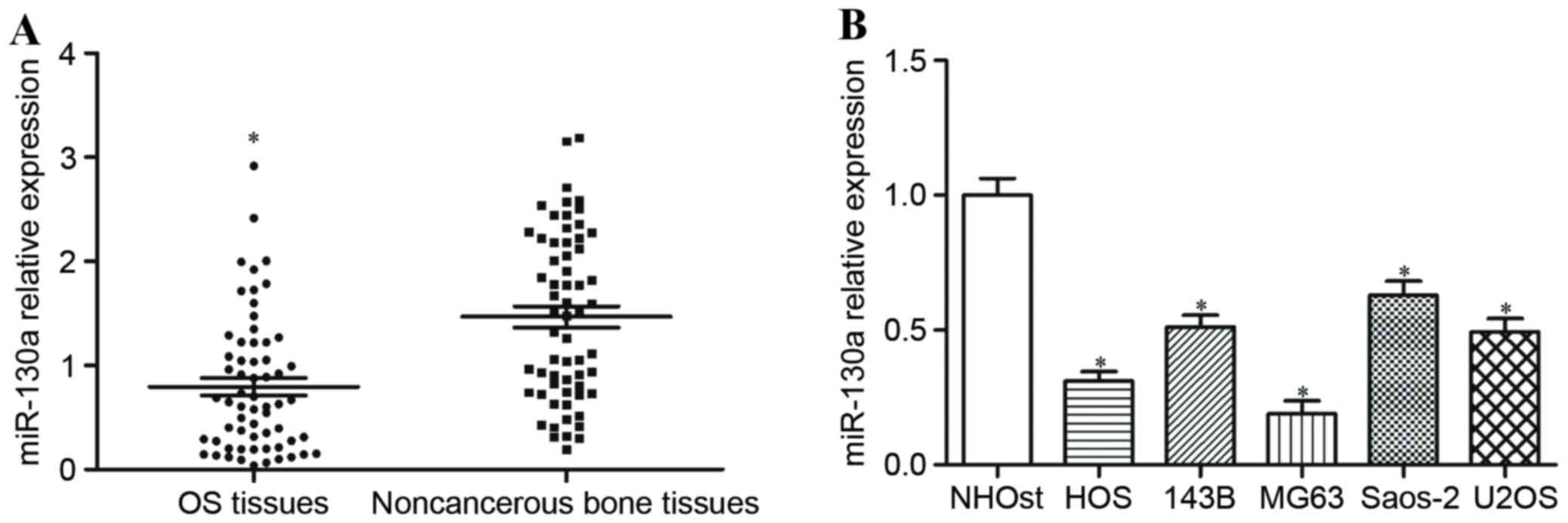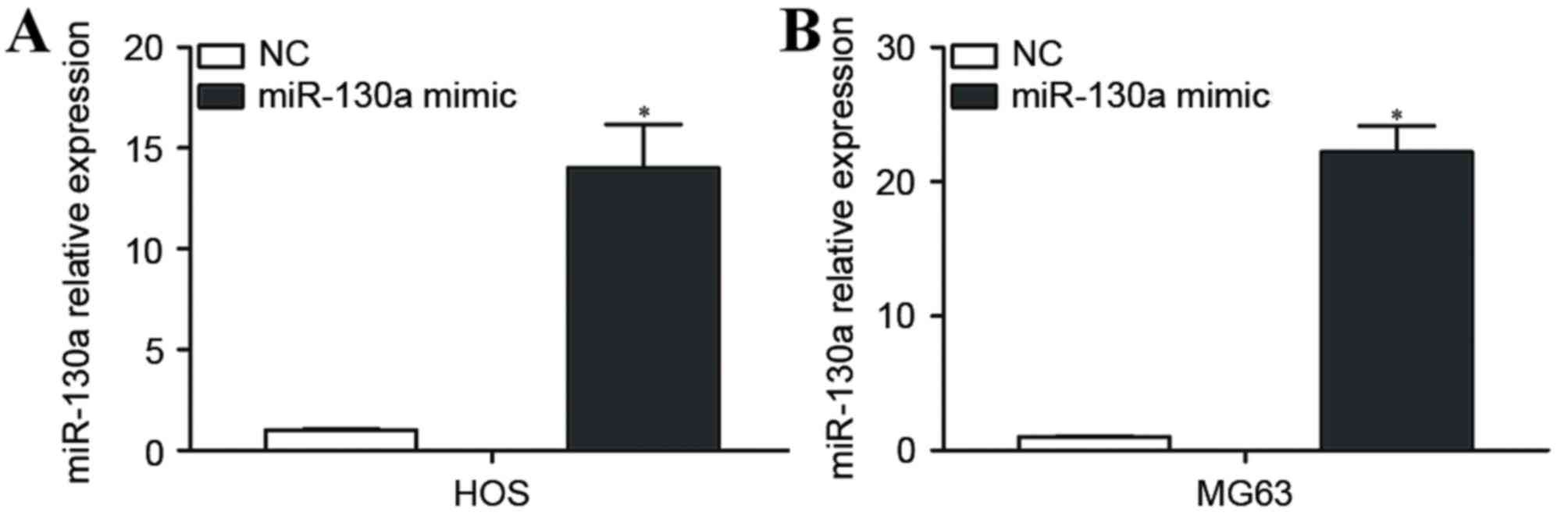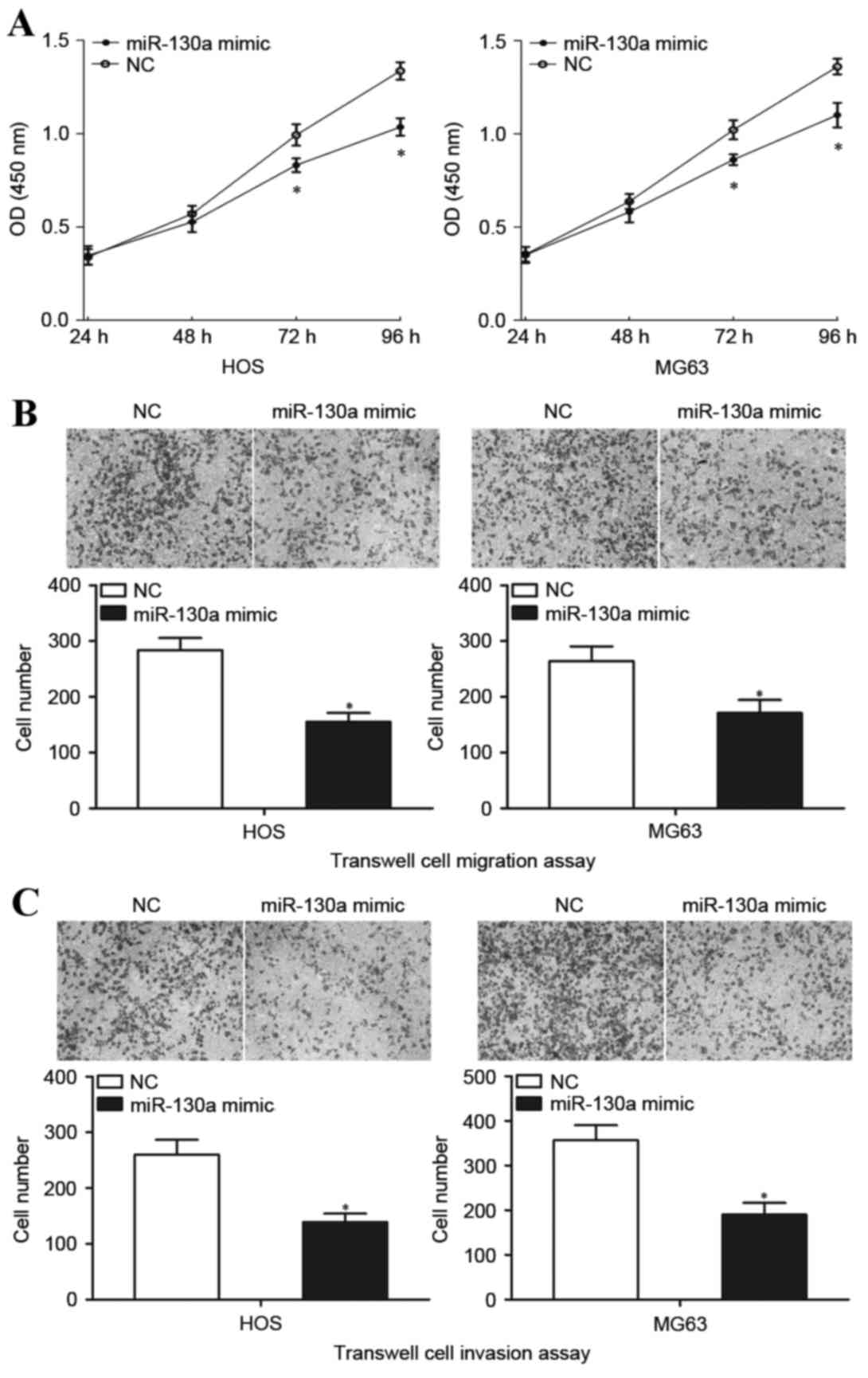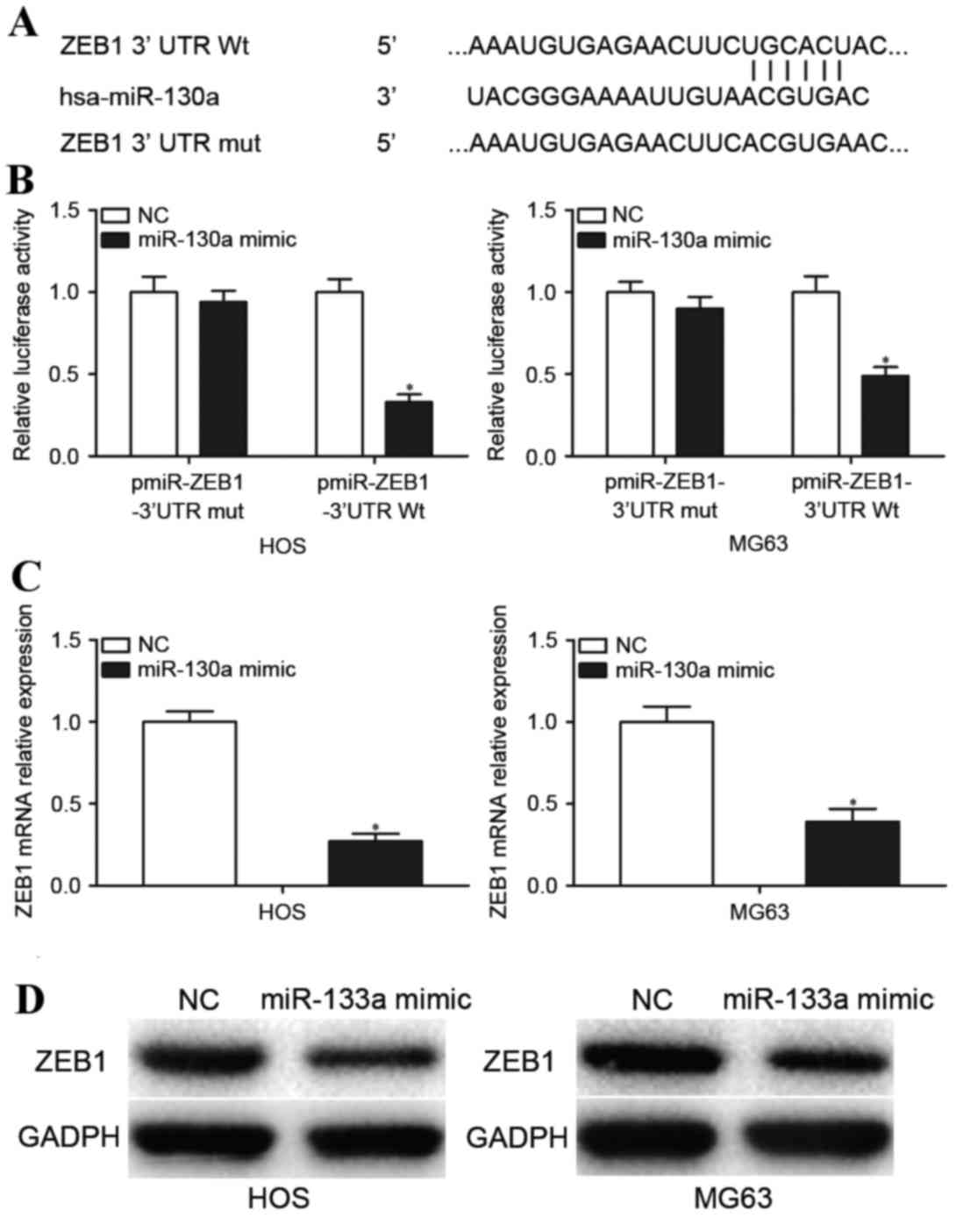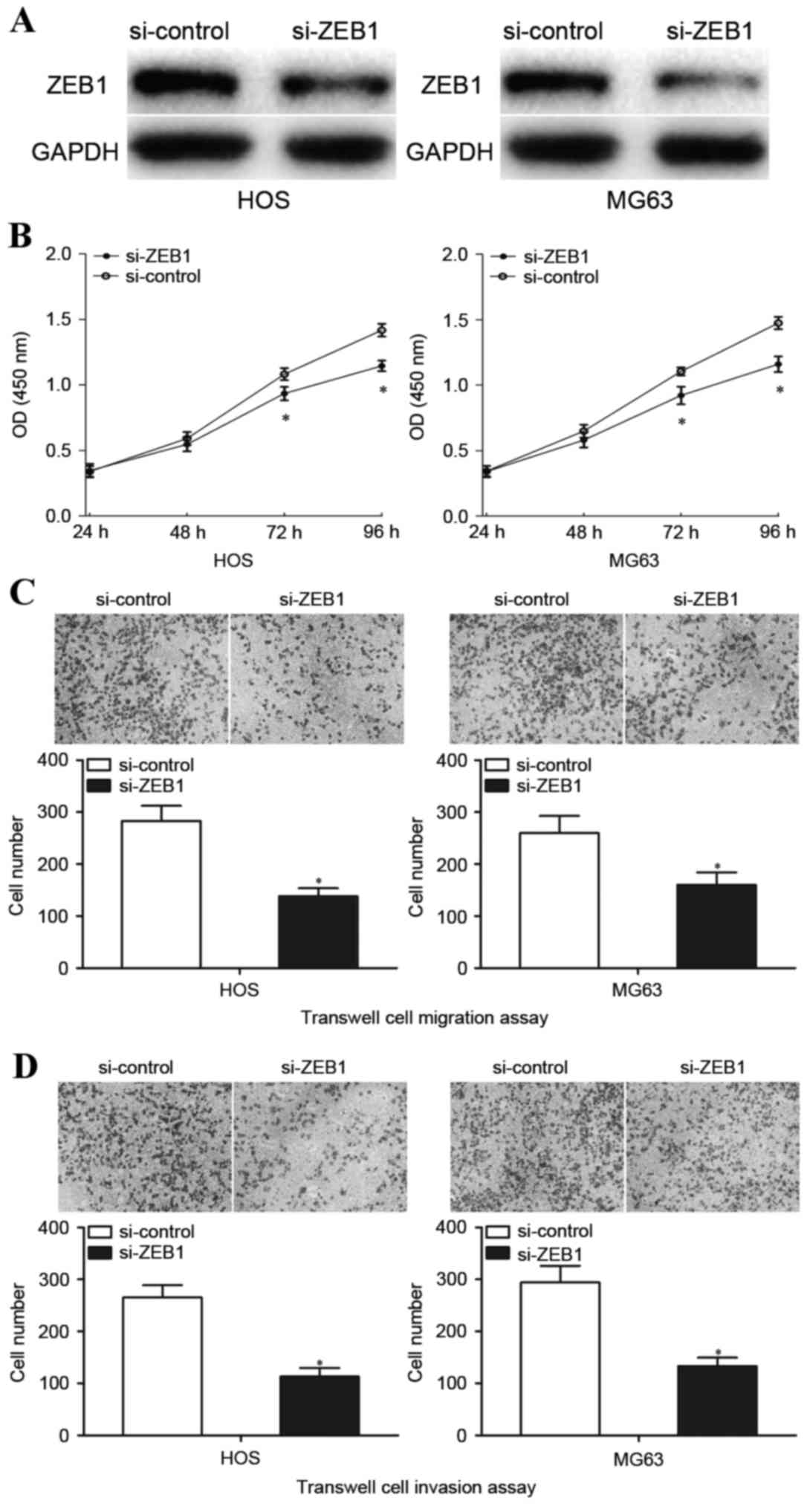MicroRNA‑130a inhibits growth and metastasis of osteosarcoma cells by directly targeting ZEB1
Retraction in: /10.3892/mmr.2022.12756
- Authors:
- Published online on: July 13, 2017 https://doi.org/10.3892/mmr.2017.6968
- Pages: 3606-3612
Abstract
Introduction
Osteosarcoma (OS), an aggressive primary sarcoma of bone, is the most common malignant bone tumor in children and adolescents, comprising ~60% of malignant bone tumors in the first 2 decades of life (1–3). It predominantly arises from the metaphysis of the long bones with active bone growth and reparation, including the knee joint, lower femur and upper tibia (4). A previous study demonstrated that OS is induced by genetic and epigenetic alterations that cause mesenchymal stem cells to differentiate into osteoblasts (5). Currently, the standard therapeutic strategy for OS is surgery followed by radiotherapy and/or chemotherapy (6). Although advances have been made in OS treatment, the prognosis for OS remains poor and the 5-year survival rate for OS patients with aggressive metastases is only 10–30% (7). The majority of patients eventually develop local relapse or metastatic disease, which is the major cause of mortality (8). Therefore, identification of the effective therapeutic targets that contribute to growth and metastasis of OS is essential for improving the prognosis of OS.
microRNAs (miRNAs) are a type of non-coding, highly conserved and small (21–23 nucleotides) RNA molecules which primarily suppress gene expression through binding to the 3′ untranslated region (3′UTR) of their target genes, eventually leading to translational repression or degradation (9,10). Increasing evidence indicates that these small molecules have important functions in a wide range of physiological and pathological processes, including growth, differentiation, apoptosis, metastasis, migration and invasion (11,12). Abnormal expression of miRNAs is significantly associated with multiple human diseases, including obesity, cardiovascular diseases and cancer (9,13). Previous studies have also demonstrated that downregulation or upregulation of miRNAs is associated with multiple types of human cancer, where they function as tumor suppressors or oncogenes depending on the function of their target genes (14–16). Notably, miRNAs have been reported to be involved in the carcinogenesis and development of OS, and may be prognostic markers or therapeutic targets for patients with OS (17–19). Therefore, miRNAs may be promising targets for OS treatment.
In the present study, the data indicated that miR-130a expression was lower in OS tissues and cell lines compared with normal bone tissues. Low miR-130a expression levels were significantly associated with clinical stage and metastasis. Furthermore, upregulation of miR-130a inhibited growth, migration and invasion of OS cells by directly targeting zinc finger E-box binding homeobox 1 (ZEB1). Overall, miR-130a may be involved in the suppression of OS growth and metastasis through ZEB1 downregulation, suggesting that it may be a promising novel therapeutic target for OS.
Materials and methods
Tissue samples, cell lines, cell culture and cell transfection
Primary OS tissues (n=62) and their matched non-cancerous bone tissues (n=62) were obtained from patients with OS who underwent surgery at the Weifang People's Hospital (Weifang, China). The matched non-cancerous bone tissues were obtained 5 cm from the tumor margin. None of these patients had received any therapeutic treatments prior to surgery. OS tissues and non-cancerous bone tissues were immediately snap frozen in liquid nitrogen and stored at −80°C. Use of these sample tissues was approved by the Ethics Committee of Weifang People's Hospital (Weifang, China), and written informed consent was collected from the patients with OS.
Human OS cell lines (HOS, 143B, MG63, Saos-2, U2OS) and a normal osteoblast cell line (NHOst) were obtained from the American Type Culture Collection (Manassas, VA, USA). Cells were cultured in Dulbecco's modified Eagle's medium (Gibco; Thermo Fisher Scientific, Inc., Waltham, MA, USA) or RPMI 1640 medium (Gibco; Thermo Fisher Scientific, Inc.) supplemented with 10% fetal bovine serum (FBS; Gibco; Thermo Fisher Scientific, Inc.) at 37°C in a humidified atmosphere with 5% CO2.
The miR-130a mimics, the negative control miRNA mimics (NC), ZEB1 small interfering RNA (si-ZEB1) and control siRNA (si-control) were purchased from Guangzhou RiboBio Co., Ltd. (Guangzhou, China). The sequence of the miR-130a mimic was 5′-CAGUGCAAUGUUAAAAGGGCAU-3′. The sequence of the NC mimic was 5′-UUCUCCGAACGUGUCACGUTT-3′. The sequence of the si-ZEB1 was 5′-AACUGAACCUGUGGAUUAU-3′. The si-control sequence was 5′-AACAGGCACACGTCCCAGCGT-3′. Transfection was performed using Lipofectamine 2000 (Invitrogen; Thermo Fisher Scientific, Inc.) when cells were grown to 80% confluence, according to the manufacturer's protocol.
Reverse transcription-quantitative polymerase chain reaction (RT-qPCR)
Total RNA was prepared from frozen tissues and culture cells using the mirVana miRNA Isolation kit (Ambion; Thermo Fisher Scientific, Inc.), following the manufacturer's protocol. For miRNA expression, TaqMan miRNA reverse transcription kit (Applied Biosystems; Thermo Fisher Scientific, Inc.) was used to synthesize cDNA from total RNA. The TaqMan miRNA assay kit (Applied Biosystems; Thermo Fisher Scientific, Inc.) was used to detect miR-130a expression, with U6 small nuclear RNA used as an internal control. This stage was performed using 40 cycles of denaturation at 95°C for 15 sec and annealing/extension at 60°C for 60 sec. For mRNA expression, cDNA was synthesized using the PrimeScript RT reagent kit (Takara Biotechnology Co., Ltd., Dalian, China), followed by RT-qPCR with Real-time PCR Mixture Reagent (Takara Biotechnology Co., Ltd.), according to the manufacturer's protocol. Glyceraldehyde 3-phosphate dehydrogenase (GAPDH) was measured as an internal control for mRNA expression. This stage was performed as follows: 42°C for 5 min; 95°C for 10 sec; and 40 cycles of 95°C for 5 sec, 55°C for 30 sec and 70°C for 30 sec. The primer sequences used were as follows: miR-130a, forward 5′-AGGATGAGAGGAAGGCTGTG-3′ and reverse 5′-AGAAAACAGTGACGCTGAGG-3′; U6, forward 5′-TGCGGGTGCTCGCTTCGGCAGC-3′ and reverse 5′-CCAGTGCAGGGTCCGAGGT-3′; ZEB1, forward 5′-CTCGAGCATTTAGACACAAGCG-3′ and reverse 5′-TTGCCCTTCCTTTCCTGTGT-3′; and GAPDH, forward 5′-CCCCCAATGTATCCGTTGTG-3′ and reverse 5′-TAGCCCAGGATGCCCTTTAGT-3′. Relative expression fold changes were calculated using the 2−ΔΔCq method (20).
Cell proliferation analysis
The effect of miR-130a on OS cell proliferation was assessed by Cell Counting Kit-8 (CCK-8; Dojindo Molecular Technologies, Inc., Kumamoto, Japan). Cells were seeded into 96-well plates at a density of 3,000 cells per well. Following incubation overnight, cells were transfected with the miR-130a mimic or NC miRNA. CCK-8 solution (10 µl) was added into each well of the 96-well plates at different time points post-transfection (24–96 h) and incubated for another 2 h. The optical density at 450 nm was detected with a microplate reader. The experiment was performed in triplicate.
Transwell cell migration and Matrigel cell invasion assays
The effect of miR-130a on OS cell metastasis was evaluated using a hanging cell culture insert (Merck Millipore, Darmstadt, Germany). For the cell migration assay, 5×104 transfected cells in 400 µl serum-free DMEM were transferred to the upper insert. For the cell invasion assay, 5×104 transfected cells in 400 µl serum-free medium were seeded into the upper chamber coated with Matrigel (BD Biosciences, San Jose, CA, USA). For both assays, the lower insert was filled with 500 µl complete medium containing 20% FBS (Gibco; Thermo Fisher Scientific, Inc.). Cells that had not migrated or invaded to the membrane of the culture insert following 48 h incubation were removed from the upper surface of the membrane with cotton swabs. Cells that had penetrated the membrane were then fixed in 100% methanol, stained with 0.5% crystal violet and the number of cells was counted in five randomly selected fields (magnification, ×100) under an inverted microscope (CKX41; Olympus Corporation, Tokyo, Japan).
miR-130a target prediction
TargetScan 6.0 (http://www.targetscan.org/vert_60/) was used to predicate the putative targets of miR-130a (21).
Western blot analysis
Transfected cells were harvested and lysed with RIPA lysis buffer. Equal amounts of protein lysate (20 µg) were separated by 10% SDS-PAGE and transferred to polyvinylidene fluoride membranes (Merck Millipore). The membranes were blocked with 5% non-fat milk in Tris-buffered saline, then incubated with primary antibodies overnight at 4°C and corresponding horseradish peroxidase (HRP)-conjugated secondary antibodies at room temperature for 2 h. The protein bands were detected with the SuperSignal West Pico Chemiluminescent Substrate kit (Pierce, Rockford, IL). The primary antibodies used in the present study were as follows: Mouse anti-human monoclonal ZEB1 antibody (1:1,000 dilution; cat. no. sc-81428; Santa Cruz Biotechnology, Inc., Dallas, TX, USA) and anti-human monoclonal GADPH antibody (1:1,000 dilution; cat. no. sc-59540; Santa Cruz Biotechnology, Inc.). The secondary antibody used in the present study was goat anti-mouse IgG+IgM-HRP (1:3,000 dilution; cat. no. ab-47827; Abcam, Cambridge, MA, USA). Protein levels were normalized to total GAPDH.
Dual-luciferase report assay
pmiR-ZEB1-3′UTR Wt and pmiR-ZEB1-3′UTR Mut plasmids were purchased from Guangzhou RiboBio Co., Ltd. OS cells were seeded into 24-well culture dishes and co-transfected with pmiR-ZEB1-3′UTR Wt or pmiR-ZEB1-3′UTR Mut and the miR-130a mimic or NC at room temperature. Cells were harvested 48 h following transfection and luciferase activities were measured using the Dual-Luciferase Reporter Assay system (Promega Corporation, Madison, WI, USA). Renilla luciferase activities were detected as an internal control for firefly luciferase activities.
Statistical analysis
The data were presented as the mean ± standard deviation. The data were evaluated using SPSS 19.0 statistical software package (IBM SPSS, Armonk, NY, USA). Differences between all variables were analyzed using Student's t-tests or Chi-square tests. P<0.05 was considered to indicate a statistically significant difference.
Results
miR-130a expression levels are decreased in OS
To explore whether miR-130a was deregulated in OS, its expression level was measured in human OS tissues and matched non-cancerous bone tissues using RT-qPCR. miR-130a expression levels were significantly reduced in OS tissues compared with non-cancerous bone tissues (P<0.05; Fig. 1A). miR-130a expression was also determined in OS cell lines and a normal osteoblast cell line, and miR-130a expression levels were significantly decreased in all five OS cell lines in comparison with the normal osteoblast cell line (P<0.05; Fig. 1B).
Correlations between miR-130a expression and clinicopathological features in patients with OS
Statistical analysis identified that miR-130a expression in patients with OS was significantly negatively correlated with clinical stage (P=0.040; Table I) and metastasis (P=0.002; Table I), but no significant associations were observed between miR-130a expression and age, sex, tumor size or location of the primary tumor (Table I).
Table I.Correlation of miR-130a expression levels with clinicopathological features in osteosarcoma patients. |
miR-130a is significantly upregulated in OS cells transfected with an miR-130a mimic
HOS and MG63 cells, which expressed relatively low levels of miR-130a, were selected for further studies, and were transfected with the miR-130a mimic or NC. RT-qPCR was performed 48 h following transfection to measure miR-130a expression. miR-130a was significantly upregulated in HOS and MG63 cells transfected with the miR-130a-mimic compared with HOS and MG63 cells transfected with NC (P<0.05; Fig. 2A).
miR-130a inhibits OS cell growth, migration and invasion
The cell proliferation assay was performed to measure the involvement of miR-130a in OS cell growth proliferation. Transfection with the miR-130a mimic significantly inhibited the growth of HOS and MG63 cells at both 72 and 96 h compared with transfection with NC (Fig. 3A). Transwell cell migration and Matrigel cell invasion assays were performed to explore the effect of miR-130a on the metastasis capacity of OS cells. HOS and MG63 cells transfected with the miR-130a mimic demonstrated significantly decreased migratory capacity compared with the cells transfected with NC (P<0.05; Fig. 3B). In addition, HOS and MG63 cells transfected with the miR-130a mimic also demonstrated significantly decreased invasion compared with the cells transfected with NC (P<0.05; Fig. 3C). These results indicated that miR-130a functions as a tumor suppressor in OS, through inhibiting growth and metastasis of OS cells.
miR-130a downregulates ZEB1 expression by directly targeting its 3′UTR
To explore the molecular mechanisms underlying the involvement of miR-130a in OS, the miRNA target prediction tool TargetScan was used to predict its target genes. Bioinformatics analysis indicates a putative conserved binding site for miR-130a in the 3′UTR of ZEB1 at 500–506 bp (Fig. 4A). Dual-Luciferase report assays were performed to explore whether miR-130a directly targeted the 3′UTR of ZEB1. Transfection with the miR-130a mimic significantly reduced the luciferase activity of pmiR-ZEB1-3′UTR Wt compared with transfection with NC (P<0.05; Fig. 4B) but not the binding pmiR-ZEB1-3′UTR Mut (P>0.05; Fig. 4B). To further validate that ZEB1 was a direct target gene of miR-130a, RT-qPCR and western blotting analysis was performed to determine ZEB1 mRNA and protein expression levels in OS cells transfected with the miR-130a mimic and NC. Transfection with the miR-130a mimic significantly decreased ZEB1 mRNA expression levels (P<0.05; Fig. 4C) and visibly deceased ZEB1 protein levels (P<0.05; Fig. 4D) in HOS and MG63 cells compared with cells transfected with the NC. These results indicated that miR-130a downregulates ZEB1 expression by directly targeting its 3′UTR.
Downregulation of ZEB1 mimicked the effect of transfection with the miR-130a mimic in OS cells
To investigate the involvement of ZEB1 in OS, HOS and MG63 cells were transfected with si-ZEB1 or si-control, and cell proliferation, Transwell cell migration and Matrigel cell invasion assays were performed. Western blot analysis was performed 72 h following transfection to detect ZEB1 protein expression. Transfection with si-ZEB1 visibly inhibited ZEB1 protein expression in HOS and MG63 cells compared with cells transfected with si-control (Fig. 5A). Transfection with si-ZEB1 significantly inhibited HOS and MG63 cell proliferation at both 72 and 96 h (Fig. 5B). Furthermore, downregulation of ZEB1 by transfection with si-ZEB1 significantly decreased HOS and MG63 cell migration (P<0.05; Fig. 5C) and invasion (P<0.05; Fig. 5D). These results indicated that downregulation of ZEB1 mimicked the effects observed when transfected with an miR-130a mimic in terms of inhibiting OS cell proliferation, migration and invasion.
Discussion
OS, the most common primary bone tumor, rapidly destroys the surrounding tissues (22). Current therapeutic strategies for patients with OS are not sufficiently effective, therefore, novel therapeutic targets are required. The abnormal expression of miRNAs has been observed in multiple human cancers, and attention has been focused on understanding the physiological and pathophysiological mechanisms of miRNAs in cancer carcinogenesis and progression, which may provide novel therapeutic targets for human cancers, including OS (17). In the present study, miR-130a expression was measured in OS tissue and cell lines, and the correlations between the clinicopathological features of OS and miR-130a expression levels were explored. The results indicated that miR-130a was significantly downregulated in OS tissues and cell lines compared with normal bone tissue and normal osteoblasts, and low miR-130a expression levels were significantly correlated with clinical stage and metastasis. Further experiments demonstrated that increasing miR-130a expression via transfection with a mimic significantly inhibited OS cell proliferation, migration and invasion. ZEB1 was identified as a direct target of miR-130a in OS, and knockdown of ZEB1 using siRNA produced similar effects as observed following transfection with an miR-130a mimic. Therefore, the present study indicated that miR-130a may be a tumor suppressor in OS via targeting ZEB1, and may be a potential novel target for the treatment of patients with OS, to block rapid growth and metastasis.
The abnormal expression of miR-130a has been observed in multiple types of cancer. For example, in hepatocellular carcinoma, miR-130a expression levels were decreased in tumor tissues compared with adjacent non-tumor tissues. Correlation analysis indicated that low miR-130a expression levels were not associated with age, sex, tumor size or location of the primary tumor, however miR-130a expression levels were significantly correlated with clinical stage and metastasis. In addition, Kaplan-Meier analysis identified that patients with low miR-130a expression had a poorer overall survival than patients with high miR-130a expression (23). Furthermore, multivariate Cox regression analysis has previously indicated that miR-130a expression is an independent prognostic factor for overall survival (23). Low expression of miR-130a has also been observed in prostate carcinoma (24) and breast cancer (25). However, in gastric cancer, miR-130a was upregulated in tumor tissues. In addition, the low miR-130a group had significantly improved overall survival in comparison with the high miR-130a group. Furthermore, miR-130a was also upregulated in the plasma of patients with gastric cancer, and the diagnostic value of miR-130a for gastric cancer is more effective than the tumor markers carcinoembryonic antigen and cancer antigen 19–9 (26). miR-130a was also reported to be upregulated in cisplatin resistant ovarian cancer (27), gefitinib-sensitive non-small-cell lung cancer (28) and cervical cancer (29). These conflicting findings indicate that the effect of miR-130a expression in human cancer has tissue specificity.
It has been previously reported that miR-130a has multiple targets through which it regulates multiple human cancers. For example, in breast cancer, miR-130a targeted RAB5A, member RAS oncogene family to suppress cancer cell growth, migration and invasion (25). Jiang et al (26) and Lee et al (30) reported that miR-130a increased gastric cancer cell proliferation, migration, invasion and angiogenesis via directly targeting runt-related transcription factor 3. Zhou et al (28) demonstrated that miR-130a suppressed cell proliferation and increased apoptosis of non-small-cell lung cancer cells treated with gefitinib through negative regulation of met. In the present study, ZEB1 was identified as a direct target gene of miR-130a in OS. Identification of miR-130a target genes is essential for elucidating the functions of miR-130a in carcinogenesis and progression of OS, and may provide effective therapeutic targets for patients with OS.
ZEB1, an E-cadherin transcriptional repressor, is a member of the zinc finger family and is located on the short arm of human chromosome 10 (31). ZEB1 was upregulated in OS tissues compared with normal bone tissues, in addition, ZEB1 expression in OS tissues with positive lung metastasis was significantly increased compared with that from patients without lung metastasis (32). Therefore, ZEB1 may contribute to the progression of OS, and may be a potential target for the treatment of OS. The present study explored whether miR-130a inhibited the growth and metastasis of OS by negative regulation ZEB1 in OS cell lines. miR-130a significantly suppressed ZEB1 mRNA and protein expression levels. In addition, downregulation of ZEB1 following transfection with siRNA resulted in a similar effect as that observed following transfection with an miR-130a mimic. It was confirmed that miR-130a inhibited OS cell growth, migration and invasion by downregulating ZEB1 expression.
In conclusion, the present study demonstrated that miR-130a was downregulated in OS tissues and cell lines. In addition, miR-130a expression levels were significantly negatively correlated with clinical stage and metastasis. Overexpression of miR-130a inhibited tumor aggressiveness by inhibiting OS cell proliferation, migration and invasion, at least in part through the targeting of ZEB1. These observations suggest that miR-130a may be a potential novel candidate for the treatment of OS.
References
|
Salah Z, Arafeh R, Maximov V, Galasso M, Khawaled S, Abou-Sharieha S, Volinia S, Jones KB, Croce CM and Aqeilan RI: miR-27a and miR-27a* contribute to metastatic properties of osteosarcoma cells. Oncotarget. 6:4920–4935. 2015. View Article : Google Scholar : PubMed/NCBI | |
|
Han G, Wang Y and Bi W: C-Myc overexpression promotes osteosarcoma cell invasion via activation of MEK-ERK pathway. Oncol Res. 20:149–156. 2012. View Article : Google Scholar : PubMed/NCBI | |
|
Tang J, Shen L, Yang Q and Zhang C: Overexpression of metadherin mediates metastasis of osteosarcoma by regulating epithelial-mesenchymal transition. Cell Prolif. 47:427–434. 2014. View Article : Google Scholar : PubMed/NCBI | |
|
Shang Y, Wang LQ, Guo QY and Shi TL: MicroRNA-196a overexpression promotes cell proliferation and inhibits cell apoptosis through PTEN/Akt/FOXO1 pathway. Int J Clin Exp Pathol. 8:2461–2472. 2015.PubMed/NCBI | |
|
Liu Y, Li Y, Liu J, Wu Y and Zhu Q: MicroRNA-132 inhibits cell growth and metastasis in osteosarcoma cell lines possibly by targeting Sox4. Int J Oncol. 47:1672–1684. 2015.PubMed/NCBI | |
|
Gorlick R: Current concepts on the molecular biology of osteosarcoma. Cancer Treat Res. 152:467–478. 2009. View Article : Google Scholar : PubMed/NCBI | |
|
Meyers PA: Muramyl tripeptide (mifamurtide) for the treatment of osteosarcoma. Expert Rev Anticancer Ther. 9:1035–1049. 2009. View Article : Google Scholar : PubMed/NCBI | |
|
Marina N, Gebhardt M, Teot L and Gorlick R: Biology and therapeutic advances for pediatric osteosarcoma. Oncologist. 9:422–441. 2004. View Article : Google Scholar : PubMed/NCBI | |
|
Ameres SL and Zamore PD: Diversifying microRNA sequence and function. Nat Rev Mol Cell Biol. 14:475–488. 2013. View Article : Google Scholar : PubMed/NCBI | |
|
Sun K and Lai EC: Adult-specific functions of animal microRNAs. Nat Rev Genet. 14:535–548. 2013. View Article : Google Scholar : PubMed/NCBI | |
|
Tahara H, Kay MA, Yasui W and Tahara E: MicroRNAs in cancer: The 22nd Hiroshima cancer seminar/the 4th Japanese Association for RNA Interference Joint International Symposium, 30 August 2012, Grand Prince Hotel Hiroshima. Jpn J Clin Oncol. 43:579–582. 2013. View Article : Google Scholar : PubMed/NCBI | |
|
Yates LA, Norbury CJ and Gilbert RJ: The long and short of microRNA. Cell. 153:516–519. 2013. View Article : Google Scholar : PubMed/NCBI | |
|
Kasinski AL and Slack FJ: Epigenetics and genetics. MicroRNAs en route to the clinic: Progress in validating and targeting microRNAs for cancer therapy. Nat Rev Cancer. 11:849–864. 2011. View Article : Google Scholar : PubMed/NCBI | |
|
Chen CZ: MicroRNAs as oncogenes and tumor suppressors. N Engl J Med. 353:1768–1771. 2005. View Article : Google Scholar : PubMed/NCBI | |
|
Bartel DP: MicroRNAs: Target recognition and regulatory functions. Cell. 136:215–233. 2009. View Article : Google Scholar : PubMed/NCBI | |
|
Caldas C and Brenton JD: Sizing up miRNAs as cancer genes. Nat Med. 11:712–714. 2005. View Article : Google Scholar : PubMed/NCBI | |
|
Namlos HM, Meza-Zepeda LA, Barøy T, Østensen IH, Kresse SH, Kuijjer ML, Serra M, Bürger H, Cleton-Jansen AM and Myklebost O: Modulation of the osteosarcoma expression phenotype by microRNAs. PLoS One. 7:e480862012. View Article : Google Scholar : PubMed/NCBI | |
|
Wang XH, Cai P, Wang MH and Wang Z: microRNA25 promotes osteosarcoma cell proliferation by targeting the cell-cycle inhibitor p27. Mol Med Rep. 10:855–859. 2014.PubMed/NCBI | |
|
Zhuo W, Ge W, Meng G, Jia S, Zhou X and Liu J: MicroRNA20a promotes the proliferation and cell cycle of human osteosarcoma cells by suppressing early growth response 2 expression. Mol Med Rep. 12:4989–4994. 2015.PubMed/NCBI | |
|
Livak KJ and Schmittgen TD: Analysis of relative gene expression data using real-time quantitative PCR and the 2(−Delta Delta C(T)) method. Methods. 25:402–408. 2001. View Article : Google Scholar : PubMed/NCBI | |
|
Lewis BP, Burge CB and Bartel DP: Conserved seed pairing, often flanked by adenosines, indicates that thousands of human genes are microRNA targets. Cell. 120:15–20. 2005. View Article : Google Scholar : PubMed/NCBI | |
|
Gu R, Sun YF, Wu MF, Liu JB, Jiang JL, Wang SH, Wang XL and Guo Q: Biological roles of microRNA-140 in tumor growth, migration, and metastasis of osteosarcoma in vivo and in vitro. Tumour Biol. 37:353–360. 2016. View Article : Google Scholar : PubMed/NCBI | |
|
Li B, Huang P, Qiu J, Liao Y, Hong J and Yuan Y: MicroRNA-130a is down-regulated in hepatocellular carcinoma and associates with poor prognosis. Med Oncol. 31:2302014. View Article : Google Scholar : PubMed/NCBI | |
|
Boll K, Reiche K, Kasack K, Mörbt N, Kretzschmar AK, Tomm JM, Verhaegh G, Schalken J, von Bergen M, Horn F and Hackermüller J: MiR-130a, miR-203 and miR-205 jointly repress key oncogenic pathways and are downregulated in prostate carcinoma. Oncogene. 32:277–285. 2013. View Article : Google Scholar : PubMed/NCBI | |
|
Pan Y, Wang R, Zhang F, Chen Y, Lv Q, Long G and Yang K: MicroRNA-130a inhibits cell proliferation, invasion and migration in human breast cancer by targeting the RAB5A. Int J Clin Exp Pathol. 8:384–393. 2015.PubMed/NCBI | |
|
Jiang H, Yu WW, Wang LL and Peng Y: miR-130a acts as a potential diagnostic biomarker and promotes gastric cancer migration, invasion and proliferation by targeting RUNX3. Oncol Rep. 34:1153–1161. 2015.PubMed/NCBI | |
|
Yang LY, Wang HJ, Jia XB, Wang X, Luo J and Zhang XY: Expression of miR-130a in cisplatin resistant cell lines of ovarian cancer. Sichuan Da Xue Xue Bao Yi Xue Ban. 43:60–64. 2012.(In Chinese). PubMed/NCBI | |
|
Zhou YM, Liu J and Sun W: MiR-130a overcomes gefitinib resistance by targeting met in non-small cell lung cancer cell lines. Asian Pac J Cancer Prev. 15:1391–1396. 2014. View Article : Google Scholar : PubMed/NCBI | |
|
Zhang J, Wu H, Li P, Zhao Y, Liu M and Tang H: NF-kB-modulated miR-130a targets TNF-α in cervical cancer cells. J Transl Med. 12:1552014. View Article : Google Scholar : PubMed/NCBI | |
|
Lee SH, Jung YD, Choi YS and Lee YM: Targeting of RUNX3 by miR-130a and miR-495 cooperatively increases cell proliferation and tumor angiogenesis in gastric cancer cells. Oncotarget. 6:33269–33278. 2015. View Article : Google Scholar : PubMed/NCBI | |
|
Liu X, Liu Y, Wu S, Shi X, Li L, Zhao J and Xu H: Tumor-suppressing effects of miR-429 on human osteosarcoma. Cell Biochem Biophys. 70:215–224. 2014. View Article : Google Scholar : PubMed/NCBI | |
|
Shen A, Zhang Y, Yang H, Xu R and Huang G: Overexpression of ZEB1 relates to metastasis and invasion in osteosarcoma. J Surg Oncol. 105:830–834. 2012. View Article : Google Scholar : PubMed/NCBI |



